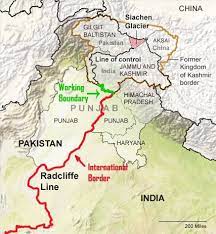The partition of British India in 1947 was a significant event in history, leading to the creation of two separate nations, India and Pakistan. Amidst the complexities of this partition, the Radcliffe Committee, also known as the Boundary Commission for the Partition of India, played a crucial role in delimiting the boundaries between these two nations. In this article, we will explore the historical significance and the impact of the Radcliffe Committee’s decisions on the partition and subsequent events.

Background of the Radcliffe Committee: As India prepared for independence, the question of dividing the country along religious lines arose due to communal tensions between Hindus and Muslims. In response, the British government appointed the Radcliffe Committee, led by Sir Cyril Radcliffe, a British lawyer and judge, to determine the boundaries between the two new nations. The committee was tasked with drawing the Radcliffe Line, which would separate India and Pakistan.
Delimitation Process: The Radcliffe Committee faced significant challenges during the delimitation process. The committee had limited time, inadequate data, and had to rely on outdated maps and incomplete demographic information. The task was further complicated by the varying religious demographics and the diverse cultural and linguistic composition of the regions. The committee had to make quick decisions that would impact the lives of millions of people.
Controversial Boundary Demarcations: The decisions of the Radcliffe Committee led to controversial border demarcations, especially in the regions of Punjab and Bengal. The committee faced immense pressure from political leaders and conflicting interests. The division of Punjab resulted in the displacement of millions of people, leading to mass migrations and violent communal clashes. The border demarcations also affected the distribution of resources, such as water from rivers that flowed through both nations, resulting in long-standing disputes.
Impact on Subsequent Events: The Radcliffe Committee’s decisions had far-reaching consequences for India and Pakistan. The partition led to widespread violence and communal riots, causing the loss of thousands of lives and the displacement of millions. The border disputes and tensions between the two nations continue to shape their relationship even today. The Radcliffe Line formed the basis of the international border between India and Pakistan, defining the geopolitical landscape of the subcontinent.
Historical Significance: The Radcliffe Committee holds immense historical significance as it played a pivotal role in shaping the political and geographical contours of India and Pakistan. The committee’s decisions had a lasting impact on the lives of millions of people, contributing to the formation of national identities, cultural shifts, and the reconfiguration of borders.
Conclusion: The Radcliffe Committee’s task of delimiting the boundaries between India and Pakistan during the partition was a daunting one, marked by challenges and controversies. While its decisions had significant consequences and resulted in widespread upheaval, the committee played a crucial role in delineating the borders that defined two independent nations. Understanding the historical context and impact of the Radcliffe Committee’s work helps us comprehend the complex legacy of the partition and its ongoing implications.
Important Links